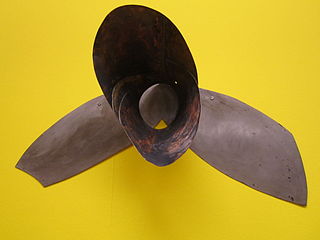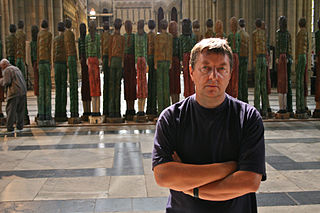Anya Gallaccio is a British artist, who creates site-specific, minimalist installations and often works with organic matter.

Gavin Turk is a British artist from Guildford in Surrey, and was considered to be one of the Young British Artists. Turk's oeuvre deals with issues of authenticity and identity, engaged with modernist and avant-garde debates surrounding the 'myth' of the artist and the 'authorship' of a work of art.

Maria Helena Vieira da Silva was a Portuguese abstract painter. She was considered a leading member of the European abstract expressionism movement known as Art Informel. Her works feature complex interiors and city views using lines that explore space and perspective. She also worked in tapestry and stained glass.
Eva Rothschild RA is an Irish artist based in London.

Dhruva Mistry is an Indian sculptor.

Pat Steir is an American painter and printmaker. Her early work was loosely associated with conceptual art and minimalism, however, she is best known for her abstract dripped, splashed and poured "Waterfall" paintings, which she started in the 1980s, and for her later site-specific wall drawings.
The Norwich Twenty Group (N20G) is a group of artists in Norfolk, England. Stimulated by contemporary art movements, the original group of 14 artists, met in November 1944, they intended to raise standards of local professional art to something worthy of the artistic history of Norfolk, by mutual criticism and appraisal of work. On 8 January 1945, they named the group the Norwich Twenty Group and a constitution was signed. N20G continues to flourish with new members. Since 1944, over 270 artists have been members. Some of the artists have included Bernard Reynolds, Edward Barker, Leslie Davenport, Michael Andrews, Mary Newcomb, Hamilton Wood, Jeffery Camp and Cavendish Morton. Since 1945 and until the end of 2013, some 150 art shows have been organised. Shows have taken place in 97 venues in Norwich, 35 in East Anglia, 11 outside East Anglia and 7 in Europe. Many of the artists trained at the Norwich School of Art and Design, now Norwich University of the Arts, Royal College of Art, Slade School of Fine Art, and other well known art schools. Many have travelled widely, studying the arts of other cultures and have exhibited regionally, nationally and internationally. Current members include 88 artists, with three life members and four honorary members. Several NUA graduates are invited to join the group every year, for one year, under the licentiate scheme. Meeting challenges in today's contemporary art, N20G now encompasses artists working in all media from paint, sculpture, installations and digital, ever seeking to nurture new members and forms of art.

Alison Mary Wilding OBE, RA is an English artist noted for her multimedia abstract sculptures. Wilding's work has been displayed in galleries internationally.

Robert Koenig is an English sculptor, who specialises in wood sculpture and is a prominent exponent of the art of woodcarving using the traditional tools of mallet and chisel. He is known for his carved and polychromed figurative wood sculptures, which he has been creating since the early 1980s. One of the earliest polychromed figures was shown in the 'Temple' exhibition at the Shaw Theatre, London in 1988.
Sophie Ryder is a British sculptor, painter, printmaker and collagist known for her large wire structures. Ryder uses materials including bronze, wet plaster embedded with found materials, sheet metal, marble, and stained glass. Additionally, her practice includes drawing, painting, and printmaking as a counterpoint to her sculptural work.
Kim Lim (1936–1997) was a Singaporean-British sculptor and printmaker of Chinese descent. She is most recognized for her abstract wooden and stone-carved sculptures that explore the relationship between art and nature, and works on paper that developed alongside her sculptural practice. Lim's attention to the minute details of curve, line and surface made her an exponent of minimalism.
Plastique Fantastique is a London-based art group active from 2004–present envisaged as a group of human and inhuman avatars delivering communiqués from the extreme past and the future. The group was originally conceived of by Simon O’Sullivan, a Senior Lecturer in Art History/Visual Culture at Goldsmiths, London, in a text written about the hypothetical architects of the exhibition New Life at Chisenhale Gallery, London, a 2004 exhibition by the artist David Burrows.
Veronica Maudlyn Ryan is a Montserrat-born British sculptor. She moved to London with her parents when she was an infant and now lives between New York and Bristol. In December 2022, Ryan won the Turner Prize for her 'really poetic' work.
Mary Sibande is a South African artist based in Johannesburg. Her art consists of sculptures, paintings, photography, and design. Sibande uses these mediums and techniques to help depict the human form and explore the construction of identity in a postcolonial South African context. In addition, Sibande focuses on using her work to show her personal experiences through Apartheid. Her art also attempts to critique stereotypical depictions of women, particularly black women.
Anna Maria Maiolino is a Brazilian contemporary artist.
Sandra Brewster is a Canadian visual artist based in Toronto. Her work is multidisciplinary in nature, and deals with notions of identity, representation and memory; centering Black presence in Canada.
Charlotte Prodger is a British artist and film-maker who works with "moving image, printed image, sculpture and writing". Her films include Statics (2021), SaF05 (2019), LHB (2017), Passing as a great grey owl (2017), BRIDGIT (2016), Stoneymollan Trail (2015) and HDHB (2012). In 2018, she won the Turner Prize.
Lettering and Sculpture Limited is a sculpture studio in Ducklington, Oxfordshire. It was incorporated in 2008, and the directors are sculptors Alec and Fiona Peever, a married couple who create art in collaboration with each other, with other sculptors, and with writers. Before and during the life of this company, the two sculptors have shown work at many art exhibitions, executed many commissions, supported several institutions, and won several awards.

Mary Spencer Watson was an English sculptor. Watson was born in London and spent most of her life in Dorset and was inspired by watching masons carving Purbeck stone, close to her family home there. Her works can be seen at Cambridge University and Wells Cathedrals, among other sites.
Rosie Leventon is a British visual artist whose practice encompasses sculpture, installation, land art, drawing and painting. She is known for making sculptural installations that reference current issues as well as the natural environment,prehistoric archaeology and vernacular architecture.







